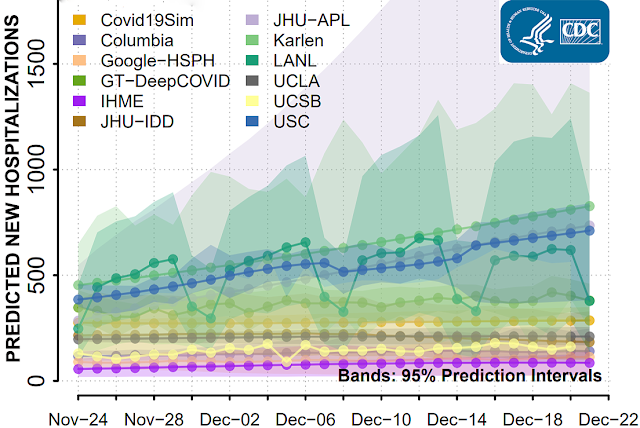Covid-19 hospitalizations in Kentucky are predicted to keep increasing; much depends on how people handled Thanksgiving

Centers for Disease Control and Prevention graph, relabeled by Kentucky Health News, shows predictions of various forecasters for new covid-19 hospitalizations in Kentucky for the next four weeks, in ranges at a statistical confidence level of 95 percent. The numbers can be downloaded.
—–
Kentucky is expected to be part of a predicted national surge in covid-19 hospitalizations after the Thanksgiving holidays. Twelve groups that do such forecasts submitted their predictions to the Centers for Disease Control and Prevention, which published them Nov. 25. Most of the forecasts are for an upward trend, and that was also the case in Kentucky.
Dr. Anthony Fauci, director of the National Institute of Allergy and Infectious Diseases, told The Washington Post a few days earlier that if Americans “do the things that are increasing the risk—the travel, the congregate settings, not wearing masks—the chances are you will see a surge superimposed upon a surge.”
The forecasts published by the CDC are based on differing assumptions, based in large part on past and expected human behavior, but there’s a big variable: how many contacts and exposures there are during the holidays.
“While it
appears that many Americans . . . scaled back on their plans for Thanksgiving, heeding the CDC’s recommendation that celebrations should be limited to only household members (people who’ve lived under the same roof for at least the last 14 days), too many have not,”
writes Frank Diamond of
Infection Control Today.
Even before the forecasts, Gov. Andy Beshear and other officials were warning that hospitals could start running short of staff and filling up. “The record for hospitalizations has been broken every day since Nov. 10,” Diamond notes.
Sarah Kliff of The New York Times said on PBS‘s “Washington Week” Friday that there fears of surges across the country like the one that plagued New York City early in the pandemic, not just that hospitals will be overwhelmed but won’t have enough staff: “There’s only so many people in the U.S. who know how to operate a ventilator, how to treat this disease.”
Some of the forecasting groups make assumptions about how levels of social distancing will change, but most assume that existing social distancing measures in each jurisdiction will continue through the projected four-week time period.
The
University of Washington‘s
Institute of Health Metrics and Evaluation estimates numbers of new hospitalizations based on numbers of forecasted deaths;
Georgia Tech’s College of Computing uses hospitalization data reported by some jurisdictions to forecast future hospitalizations; and the
Karlen Working Group uses the rate of reported infections to estimate the number of new hospitalizations in a given jurisdiction, unless the rates of reported infections and hospitalizations differ. In that case, the rate of reported hospitalizations is used to forecast new hospitalizations.
